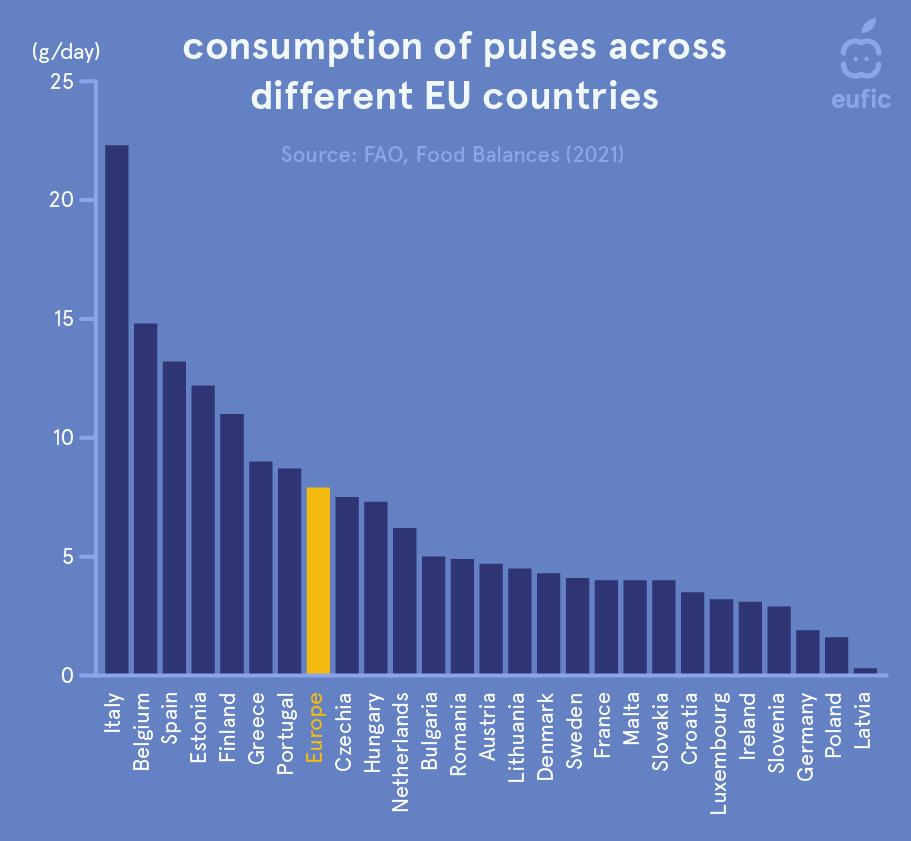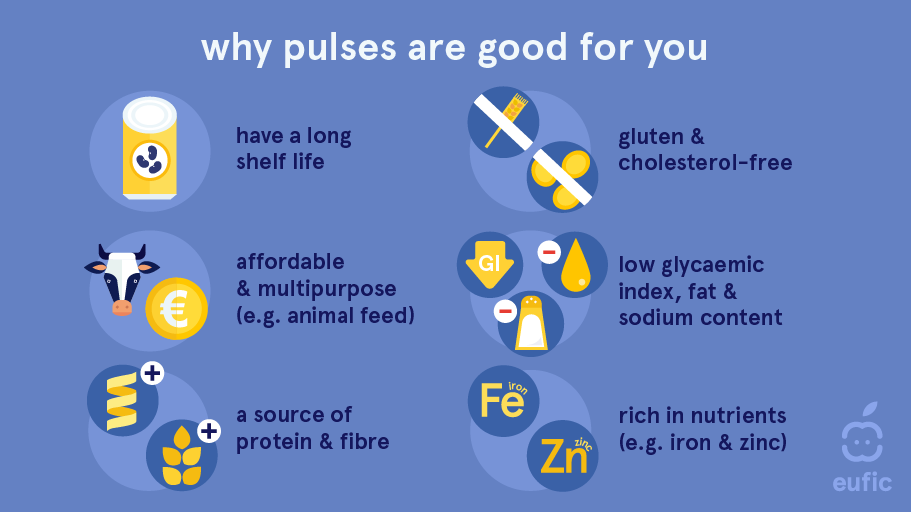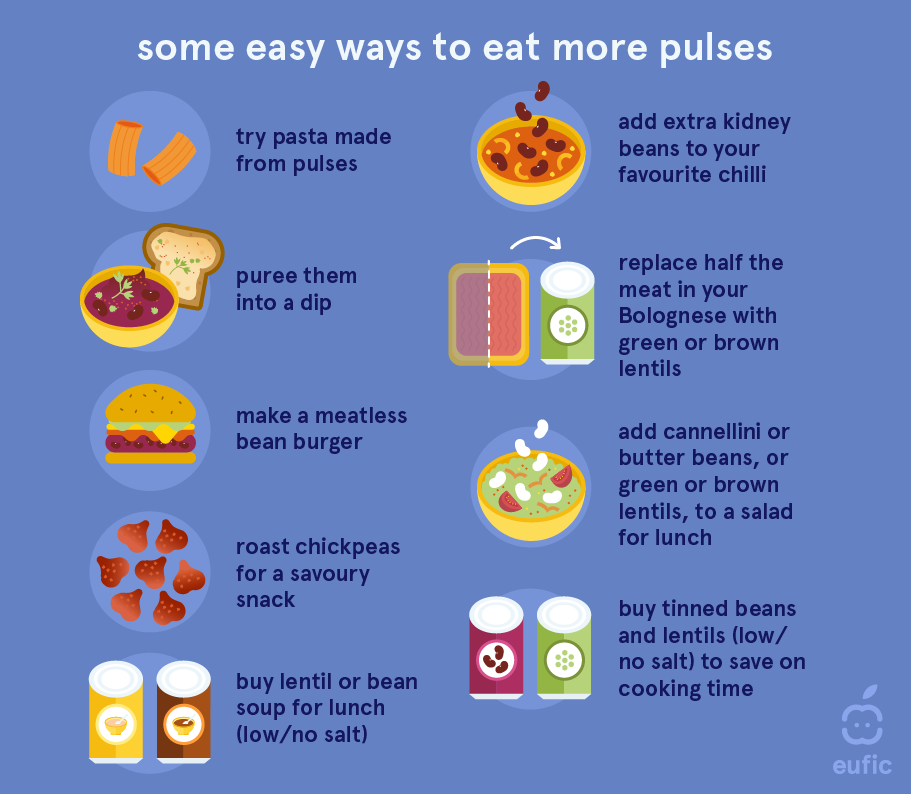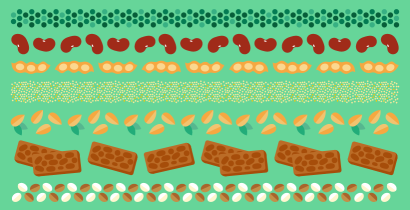Pulses (Q&A)
Last Updated : 07 February 2024High in protein, fibre, vitamins, minerals, and low in fat… we’re talking about pulses! These tiny protein-packed foods do not only taste delicious, but they are also a simple and affordable solution to help tackle the climate, health, and cost-of-living crises. This article explores what pulses are, the different types of pulses, their health and environmental benefits, and tips on how to include them into your diet.
What are pulses?
Pulses refer to the edible dried seed that comes from plants in the legume family. It is estimated that pulses have been eaten for at least 10,000 years and are among the most extensively used foods in the world. Pulses are eaten in the form of whole seeds, split grains, dehulled split grains, and flour. There are many different types of pulses grown and eaten around the world. These most common include the common bean, chickpea, dry pea, lentil, cowpea, mung bean, urd bean, and pigeon pea.1
Pulses count towards one (but not more) of your 5-a-day. The reason that they do not count to more servings of your 5-a-day is because they do not provide the same mixture of vitamins, minerals, and other nutrients as fruits and vegetables. One portion of pulses is approximately 80 g or 3 heaped tablespoons.
What is the difference between pulses and legumes?
Pulses, legumes, and beans do not necessarily refer to the same thing. While all contribute to a healthy and sustainable diet and should be eaten regularly, legumes refer to whole plants whose fruit is enclosed in a pod. Some of the most popular legumes include fresh peas, peanuts (although more commonly considered a nut because of their nutritional composition), soybeans, and green beans. The edible dried seeds that come from plants in the legume family are called pulses. In other words, all pulses are considered legumes, but not all legumes are considered pulses. Lentils, chickpeas, and split peas are all examples of pulses. Fresh soybeans, fresh peas, and fresh beans are not considered pulses because they are not dried prior to preparation and consumption. Beans in their various forms (e.g., kidney, black, pinto, navy, chickpeas) are one type of pulse.1

What are the different types of pulses?
From chickpeas, black beans and lentils to peas and many more, there is a wide variety of pulses to choose from. The United Nations Food and Agriculture Organization recognises 16 species of pulses:2
Common bean, such as black bean, pinto bean, navy bean, white (cannellini) bean, and kidney bean
- Lima bean
- Mungo bean
- Adzuki bean
- Mung bean
- Rice bean
- Moth bean
- Cowpea
- Bambara groundnut
- Hyacinth bean
- Pea
- Chickpea
- Broad bean
- Lentil
- Lupine
- Pigeon pea
Pulses can also be used to make foods such as falafel, hummus, dahl, vegetarian burgers and other plant-based meat alternatives.
Are pulses carbohydrates or protein?
Pulses are a source of both carbohydrates and protein. Pulses are unique in that they contain a higher proportion of protein compared to most other plant-based foods. Pulses typically contain 21-25% protein (dry weight) – almost double than that found in cereals – and about 50-65% carbohydrates.3,4 This is equal to about 8.2 grams of protein and 14.4 grams of carbohydrates, on average, per 100 grams of boiled pulses.5 In many food-based dietary guidelines, pulses are grouped together with other protein-rich foods, such as meat, eggs, and fish, rather than with other carbohydrate-rich foods, such as pasta, bread, and rice.
How many pulses do we eat in Europe?
The intake of pulses varies across regions and countries and, within countries, across different socio-economic classes. However, the average consumption of pulses in Europe is one of the lowest globally at about 8 g per day.6 A possible explanation for this low consumption is that when income increases, people tend to shift to more animal-based protein sources, and as a result, the consumption of pulses declines.1

What are the health benefits of pulses?
Nutrients in pulses
Pulses are incredibly rich in nutritional value. Pulses provide protein and dietary fibre, as well as a significant source of vitamins and minerals, such as B-vitamins (thiamine, riboflavin, niacin, B6, and folate), iron, zinc, magnesium, phosphorus, and potassium.1 Pulses also have a lower glycaemic index. The lower glycaemic index of pulses (slow breakdown of carbohydrates and slow release of glucose into the bloodstream) is attributed to higher contents of indigestible carbohydrates such as dietary fibres, resistant/indigestible starch and some oligosaccharides. The way of cooking and preparing also impacts the glycaemic index. Pulses are also low in fat and sodium and are gluten- and cholesterol-free. Pulses are also high in phytochemicals and other chemical compounds that may have antioxidant and anti-carcinogenic effects. Pulses can also be sprouted, which enhances their phytochemical content, vitamin C content, protein digestibility, and antioxidant activity.
Chronic disease risk
As part of a varied, balanced diet, pulses may help prevent the development of various chronic diseases. There is evidence that links eating pulses to a lower risk of cardiovascular diseases (CVD), type 2 diabetes, and certain cancers.4 Pulses may reduce the risk of CVD and type 2 diabetes by improving several risk factors, such as Haemoglobin A1c (a marker for diabetes control that can give clinicians an overall picture of what long-term average blood sugar levels have been), low-density lipoprotein (LDL) cholesterol, body weight, and blood pressure.7 These improvements are seen at consumption patterns of 120-132 g/day (equivalent to just over one serving/day).
Since pulses are rich in fibre, they can also help reduce cancer risk. The World Cancer Research Fund states that there is strong evidence that foods containing dietary fibre decrease the risk of colorectal cancer and the risk of weight gain, overweight, or obesity.8 In turn, being overweight or living with obesity is strongly associated with 13 different types of cancers, including breast cancer, pancreatic, oesophageal and gallbladder (three of the hardest to treat cancers), ovarian cancer, and stomach cancer. Other components besides fibre may also be responsible for possible anti-cancer effects of pulses, including zinc, selenium, and other plant compounds like saponins, protease inhibitors, phytic acid, and tannins.4
Anti-nutrients in pulses
Anti-nutrients are chemicals that are found in plant-based foods that can interfere with how our body absorbs nutrients. Examples in pulses include phytates, which may inhibit the absorption of iron, zinc, and calcium and lectins, which may alter gut function and cause inflammation. Another type of anti-nutrients can be found in soy, called phytoestrogens, which may act as endocrine active substances (chemicals that may interact with the hormonal system).9 Although pulses contain anti-nutrients, they are still healthy choices.
When cooked properly, there is currently no strong evidence from human trials supporting such claims and untoward effects. Soaking, boiling, germination, and fermentation are all preparation methods that significantly reduce the amount of anti-nutrients present in legumes. The health-promoting effects of essential amino acids, prebiotic fibres, vitamins, minerals, and antioxidant compounds present in pulses far outweigh any possible negative effects of anti-nutrients. In fact, anti-nutrients like lectins and phytates are now increasingly recognised for their anti-inflammatory characteristics and potential benefits against cancer.9

What are the environmental benefits of pulses?
Pulses offer several environmental benefits, contributing to sustainable agriculture and reducing the environmental impact of food production.10-12
Fix atmospheric nitrogen
An important attribute of pulses is that they can fix nitrogen from the air with the help of nitrogen-fixing bacteria in their root nodules. This process enhances soil fertility by providing a natural source of nitrogen (such as ammonium or nitrate). As a result, this reduces the need for nitrogen fertilisers, which, in turn, reduces negative environmental impacts associated with overapplication of fertilisers, such as greenhouse gas emissions and runoff into water systems.
Improve biodiversity
The nitrogen-fixing ability of pulses helps increase soil biodiversity. A high soil biodiversity provides an ecosystem with not only greater resistance and resilience against disturbance and stress, but it also improves the ability of ecosystems to suppress diseases.
Contribute to food security
Pulses also play an important role in various cropping systems, including intercropping, crop rotation, and agroforestry. These systems, characterised by higher species diversity compared to monocrops, can lead to more efficient use of resources (such as light, water, and nutrients), increased yields, and reduced risk of crop failure. Including pulses in crop rotations improves soil health and reduces the risks of soil erosion and depletion. Again, this provides benefits for food security and economies.
Another way pulses contribute to food security is that they have a long shelf-life. This long shelf-life helps to reduce the proportion of food waste at the consumption stage, thus contributing to household food security.
Mitigate climate change
Pulses can also be key to mitigating climate change and increasing resilience to climate change due to their ability to thrive in diverse environmental conditions and the fact that their production results in much lower greenhouse gas emissions than other sources of protein. For example, per 100 grams of protein, beef emits about 50 kg of greenhouse gases, whereas pulses emit only 0.84 kg.13 Pulses’ tolerance to drought and ability to enhance soil fertility also make them resilient crops in the face of changing climate patterns. The genetic diversity of pulses is also an important attribute because researchers can cultivate more climate-resilient varieties, such as those that are better resistant to heat stress.
Pulses also require less water and land than other sources of protein. For example, it can take up to seven times more water and twenty-two times more land to produce 1 kg of protein from beef than it does to produce 1 kg of protein from pulses.13

What are recipes that include pulses?
Pulses can be used in a variety of meals in the same way as other protein-rich foods such as meat and fish. You can use pulses to replace some or all the meat in dishes like pasta sauces, stews, soups, or curries. Make a hearty lentil Bolognese pasta or nourishing lentil soup, or turn them into black bean burgers; the possibilities are endless! Cooking pulses from scratch can be time-consuming; however, pulses are also readily available canned and ready-to-consume, which makes it easier to incorporate them into your diet.
Some easy ways to eat more pulses:
- Buy tinned beans and lentils (choose the ones without added salt) to save on cooking time
- Add cannellini or butter beans, or green or brown lentils to a salad for lunch
- Buy lentil or bean soup (tinned or fresh) for lunch (choose the ones low in salt)
- Add extra kidney beans to your favourite chilli
- Puree them into a dip to have with vegetable crudités, whole grain crackers, or spread on sandwiches
- Replace half the meat in your Bolognese with green or brown lentils
- Roast chickpeas for a savoury snack
- Make a meatless bean burger
- Try pasta made from pulses

Summary
Pulses might be small, but they are mighty! Pulses are nutritious, good for the planet, and affordable, versatile and delicious. Pulses are rich in proteins, slow-digesting carbohydrates, vitamins, minerals, and dietary fibre and are low in fat. Pulses may help to lower the risk of cardiovascular diseases, type 2 diabetes, certain cancers, and overweight/obesity. Pulses are also climate-friendly. They are climate resilient and water efficient, can contribute to food security, can improve soil diversity, and can fix atmospheric nitrogen and increase its content in the soil. Plus, they have a small carbon and food waste footprint. Pulses are also very affordable protein-rich options. They can be bought dry, canned or jarred and can be stored for long periods of time.
Currently, we are eating very little pulses in our diet in Europe, suggesting a potential for pulses to make a significant contribution to help tackle the climate, health, and cost-of-living crises. Whether this is by making a meatless bean burger, replacing a part of the meat in your Bolognese with lentils, or by having chickpeas in the form of hummus as a sandwich spread, all small steps count to up your pulses intake!
References
- Rawal, V., & Navarro, D. K. (2019). The global economy of pulses.
- Grande, F., Stadlmayr, B., Fialon, M., Dahdouh, S., Rittenschober, D., Longvah, T., & Charrondiere, U. (2017). FAO/INFOODS global food composition database for pulses, version 1.0. Rome: FAO.
- Singh, N. (2017). Pulses: an overview. Journal of Food Science and Technology, 54, 853-857.
- Mudryj, A. N., Yu, N., & Aukema, H. M. (2014). Nutritional and health benefits of pulses. Applied Physiology, Nutrition, and Metabolism, 39(11), 1197-1204.
- Dutch Food Composition Database (NEVO). NEVO-online version 2021/7.1. Retrieved from https://nevo-online.rivm.nl/Home/en
- Food and Agriculture Organization of the United Nations. (2021). Food Balances (2010-). Retrieved from https://www.fao.org/faostat/en/#data/FBS (Accessed 12/12/2023)
- Viguiliouk, E., Blanco Mejia, S., Kendall, C. W., & Sievenpiper, J. L. (2017). Can pulses play a role in improving cardiometabolic health? Evidence from systematic reviews and meta‐analyses. Annals of the New York Academy of Sciences, 1392(1), 43-57.
- World Cancer Research Fund/American Institute for Cancer Research. Continuous Update Project Expert Report 2018. Wholegrains, vegetables and fruit and the risk of cancer. Available at dietandcancerreport.org
- Petroski, W., & Minich, D. M. (2020). Is there such a thing as “anti-nutrients”? A narrative review of perceived problematic plant compounds. Nutrients, 12(10), 2929.
- Food and Agriculture Organization of the United Nations. (2016). Pulses and biodiversity. Retrieved from https://www.fao.org/fileadmin/user_upload/pulses-2016/docs/factsheets/Biodiversity_EN_PRINT.pdf (Accessed 12/12/2023)
- Food and Agriculture Organization of the United Nations. (2016). Pulses and climate change. Retrieved from https://www.fao.org/fileadmin/user_upload/pulses-2016/docs/factsheets/Climate_EN_PRINT_02.pdf (Accessed 12/12/2023)
- Food and Agriculture Organization of the United Nations. (2016). Pulses contribute to food security. Retrieved from https://www.fao.org/fileadmin/user_upload/pulses-2016/docs/factsheets/FoodSecurity_EN_PRINT.pdf (Accessed 12/12/2023)
- Our World in Data. (2022). Environmental Impacts of Food Production. Retrieved from https://ourworldindata.org/environmental-impacts-of-food#licence (Accessed 09/10/2023)
